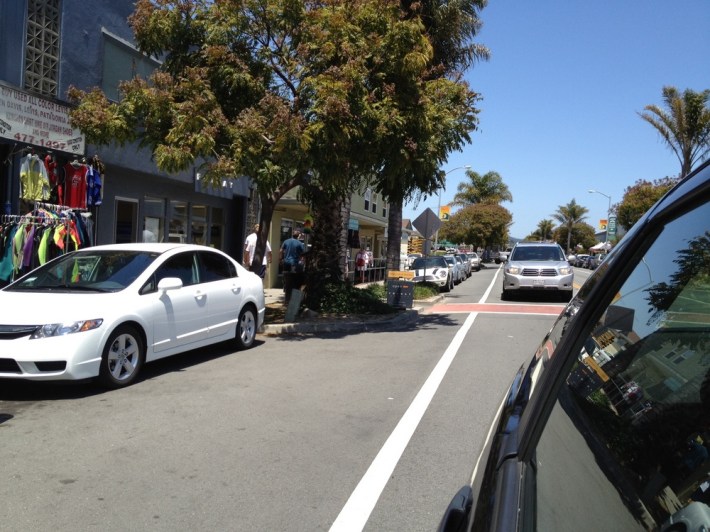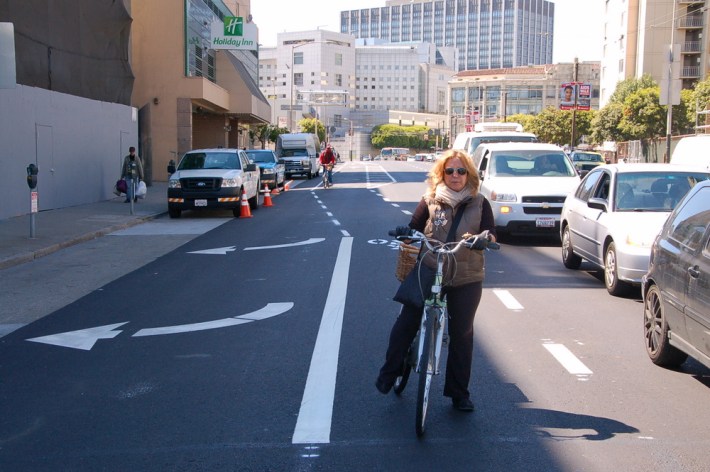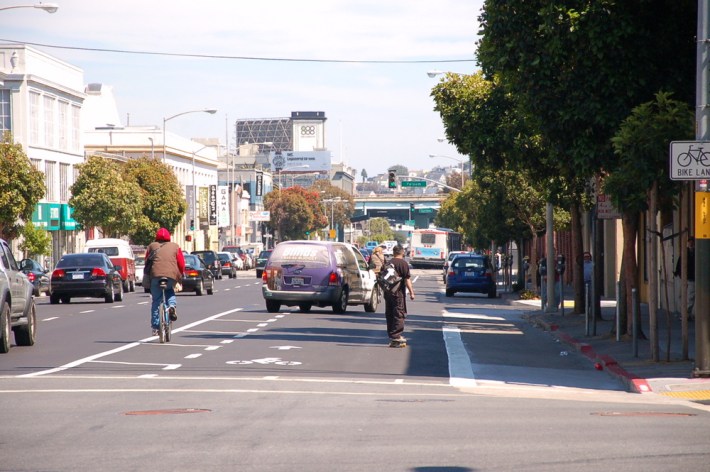8th St. Buffered Bike Lane a Step Up, But When Will SoMa Really Feel Safe?
4:16 PM PDT on July 13, 2012
A new buffered bike lane was striped on 8th Street last week, re-purposing a traffic lane for bicycles on one of SoMa's fast, one-way motorways. The new configuration, which removes bicyclists from the door zone and provides a much wider lane, is an improvement over the four speed-inducing traffic lanes and skinny bike lane that previously existed. Still, many say it's just a small step toward a truly safer street.
The bike lane upgrade was included as part of a re-paving project at the urging of bike advocates and D6 Supervisor Jane Kim, who wanted to seize the opportunity to re-configure the street striping as a cost-effective way to help calm motor traffic, create a more comfortable space for bicycling, and reduce crossing distances for pedestrians.
"Eighth Street was prioritized partially because of its history of pedestrian injuries," said Kim. "While SoMa is a mixed use neighborhood, we have many residents -- families and seniors, in particular -- on Eighth between Mission and Folsom, that cross these dangerous speeding intersections daily. The traffic calming efforts, repaving, bike lanes and speed limit reductions on Howard and Folsom are helping to change that dynamic."
"Eighth street is an important connector corridor between the Civic Center, Tenderloin and SoMa neighborhoods," she added. "As the neighborhood grows, I want to see more people walking and biking as their first choice of transportation to make short trips."
Leah Shahum, executive director of the SF Bicycle Coalition, said the organization urges "the city to take advantage of more of these opportunities to piggyback onto existing repaving projects to make low-cost, yet significant, safety improvements."
"In the case of Eighth Street, it was originally scheduled to be put back the way it was, which was more room for auto traffic than was needed and sub-standard bike space," she said. "Now, thanks to the changes, we have a more comfortable bikeway for the growing number of people riding and we have a safer street for people to cross on foot."
However, advocates and readers have noted that the layout is far from ideal. "There's still the need to slow down the traffic on this street, as it still moves far too fast for what it should be -- a neighborhood street," Shahum said. Some motorists also drive in the bike lane, as it's wide enough to accommodate them and lacks any physical barrier keeping them out. Muni buses must also now cross the wider bike lane and the parking lane to access bus stops.
Alison Sant, a SoMa resident who regularly bikes on Eighth with her husband and children, said she's excited to see incremental improvements in her neighborhood, but that "we really need to look to more extensive measures including physically separated bikeways, two-way streets, slower speeds and greening to create more livable streets in this area."
"We feel extremely exposed with cars rushing toward on-ramps at top speed with little regard for the pedestrians and bicyclists that share these streets," said Sant, who bikes to work at the Studio for Urban Projects at Bryant and Seventh Streets. "It often feels like you are on a freeway walking and cycling in this neighborhood."
Walk SF Executive Director Elizabeth Stampe said "they could certainly do more to narrow the street visually and calm it, make the crossing shorter, and provide some protection for pedestrians."
The long-term plan for Seventh and Eighth Streets recommended in the recent multi-agency Eastern Neighborhoods Transportation Implementation Planning Study (EN TRIPS) includes a parking-protected bike lane, pedestrian bulb-outs, and greening. By moving the buffered bike lane to the curb and placing the car parking lane to its left, a parking-protected bike lane would provide a physical barrier separating motor traffic and bike traffic, and the design could include pedestrian islands at the crosswalks. Bus stop boarding islands could also eliminate the need for Muni buses to switch lanes.
San Francisco's first parking-protected bike lane was successfully implemented on John F. Kennedy Drive in Golden Gate Park, though it didn't require the concrete work that Seventh and Eighth would, since it lacks a transit line.
The funding and implementation plan for EN TRIPS is still being developed, so it isn't known yet how long the Seventh and Eighth Street projects would take to complete. However, the study recommended a phased implementation, and the city has yet to release an implementation plan. Typically such projects take years to get built in San Francisco.
Similar but simpler street redesigns in New York have progressed from public presentation to implementation in less than a year. In 2012, the city is adding protected bike lanes with pedestrian refuges to segments of at least three Manhattan avenues.

While the EN TRIPS plan wouldn't convert Seventh and Eighth to two-way traffic, which could go even further toward calming the streets, Stampe said that change isn't crucial, provided other major traffic-calming methods are used. As an example of a cost-effective tool to visually reduce the freeway-like character the street, she pointed to planting trees in the parking lane, which has been done on commercial streets in cities like Palo Alto and Santa Cruz.
"I think generally, I would like to see these streets two-way, but it is possible to use other solutions to calm traffic along here," she said. "What we've seen here is very minimal, and we clearly need to see physical changes."
Read More:
Stay in touch
Sign up for our free newsletter







